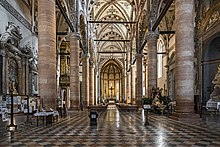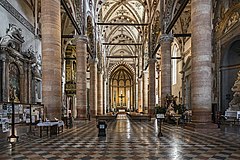Sant'Anastasia (Verona)
The Gothic brick church Sant'Anastasia is the largest church building in the northern Italian city of Verona .
history
The Ostrogothic King Theodoric had two small churches built at this point where the Via Postumia ended in Roman times , which were consecrated to Saints Anastasia and Remigius . In 1261 they were given to Dominicans, who decided in 1290 to build a church there, consecrated to one of their own martyrs , Peter of Verona . However, the name Sant'Anastasia was still used in the population.
By 1323 the choir chapels, the transept and the first nave yoke were vaulted. After that there was only a delay. The portal was in progress around 1335, the campanile was built around the middle of the 15th century, and the nave was completed in 1481. The church was extensively restored from 1878 to 1881 and 1945 to 1947.
Exterior construction
In comparison to the north German brick Gothic, the two-dimensional unity of the outer skin is striking. On the facade this can be explained by the lack of cladding. Only the portal itself and the lower zone of the buttresses are covered with marble. The double-gate portal takes up the entire width of the central nave. The layering of different colored marble in the vestments is continued in the archivolts . The lintel is decorated with reliefs from the New Testament. The three fields of the tympanum contain faded frescoes of the Holy Trinity, St. Dominic and the citizens of Verona. The reliefs on the side buttresses show the sermon and martyrdom of the Dominican saint Peter Martyr .
Interior
Round pillars divide the nave into three naves. Choir chapels are connected to the extensive transept in the east, which, contrary to the tradition of German mendicant churches, are not straight but closed polygonally, a type of floor plan that the Cistercians had conveyed from France to Italy. The colors typical of Verona with the layering of warm red and yellow tones contrasts with the vaulted vault painting of the 19th century.
Furnishing
At the first long pillars there are two holy water basins supported by hunchbacked dwarfs (Italian: " gobbi "); the right is dated 1591, the left is attributed to the sculptor Gabriele Caliari, father of Paolo Veronese .
Right, south aisle
The altar and burial place in the first side chapel on the right were built for the Venetian condottiere Diano Fregoso († 1525). The Arco dei Gavi in Verona was probably the model for the structure. Danese Cattaneo, a student of Jacopo Sansovino , created the triumphal arch-like tomb with the figure of the Redeemer according to the inscription in 1565. The following side altar in a niche from the late 15th century, finely decorated by Pietro da Porlezza, is dedicated to the Dominican saint Vincent Ferrer (altar painting from the 18th century) . Century).
In the third side chapel, built in 1490, there is an immaculata by the sculptor Orazio Marinali (1643–1720) from Vicenza. The architecture of the 4th altar is from 1541. The fourth altar shows St. Martin by Francsco Caroto (1480–1546). The Mazzoleni altarpiece in the last chapel on the right consists of a rounded arched frame with the depictions of Saints Maria Magdalena , Katharina and Toscana by Liberale da Verona . A late Gothic portal in the front wall of the north transept leads to the sacristy, which was donated in 1453.
Left, north aisle
The reredos in the first left side chapel contains figures of St. Sebastian and Rochus on the side of St. Peter of Verona .
The altar of the Manischalchi family in the next yoke is particularly elaborately designed. The Veronese Niccolò Giolfino painted the central picture Pentecost miracle in 1518 , which is flanked by niche figures from the late 15th century.
After the early baroque organ gallery in the third yoke (counted from the entrance), the access to the Cappella del Rosario opens with its baroque furnishings. Only the altarpiece consists of a 14th century fresco transferred to canvas , it depicts the Mother of God, who gives St. Dominic and Peter of Verona recommend the kneeling donors from the della Scala family .
In the north wall of the transept, a late Gothic portal leads into the chapel-like sacristy from 1453 with the roughly contemporary glass paintings , pews from 1493 and paintings from the 17th century.
Choir and transept chapels
The main chapel, which was rebuilt in the 20th century, houses the grave monument of Condottiere Cortesia Serego, a military leader of the last Della Scala, 1424–1429, on the left wall. The sculptor of this equestrian monument was Nanni di Bartolo, a student of Donatello . Opposite a fresco of the Last Judgment from the second half of the 14th century. The next chapel on the right is that of the Pellegrini family, it is lined with terracotta reliefs and tiles. The chapel of the Cavalli family, on the far right, contains the late work of the Veronese painter Altichiero da Zevio on the right side wall : Three kneeling knights of the Cavalli family are recommended to the enthroned Madonna by their patron saints Martin, Georg and Jacobus. The fresco must have been created before the tomb for Federico Cavalli was erected in 1390, perhaps as early as 1375.
Pisanellos “Departure of St. Georg on the fight with the dragon "
The main attraction of Sant'Anastasia, however, is a fresco that was painted by Antonio Pisanello from 1433 to 1438 with the theme "St. George's departure to fight the dragon". In the history of art, this fresco is considered to be the climax and endpoint of courtly Gothic in northern Italy, before the Renaissance changed the ideals of painting. Here Pisanello emphasizes “the noble demeanor of the people, the splendor of armor and robes, the mysterious and fantastic pompous facades of the Gothic city in the background, the macabre-realistic detail of the gallows with its hanged people above the noble council assembly - an idealized synopsis of the power and glory of the world of the just setting Middle Ages. "
It shows how St. George swings into the saddle to defeat the dragon and save the princess of Trebizond . The scene is full to the brim with motifs from the life of a knight, with naturalistic themes - the two hanged men on the gallows - with landscape vedutas and architectural elements. The princess is the person in the foreground.
It is typical of the courtly Gothic that it is not the moment of struggle and victory - which has already been created countless times - that is recorded, but the quiet moment of parting from the princess. The motif of the horse's back between the two people and the head with the two ears above it is interesting: here we already have a strong perspective foreshortening and a creation of spatial depth in an actually still Gothic painting, carried out on one of the favorite motifs of the early Renaissance, the horse.
Individual evidence
- ↑ Walter Pippke, Ida Pallhuber: Lake Garda, Verona, Trentino. Cologne [1986] 4th edition 1989, p. 287.
literature
- Manfred Wundram (Ed.): Upper Italy East (Reclams Art Guide Italy Vol. 2). Pp. 1037-1043.
Coordinates: 45 ° 26 ′ 43 ″ N , 10 ° 59 ′ 59 ″ E






